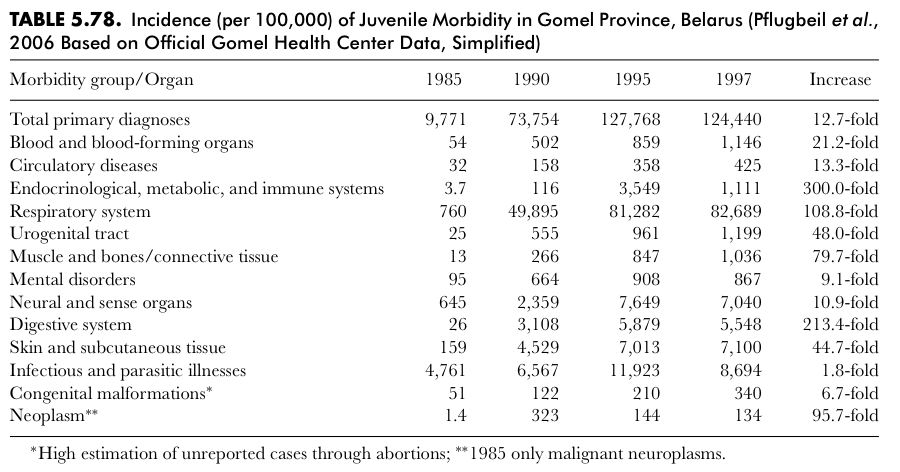• • •
"Mike and Jon, Jon and Mike—I've known them both for years, and, clearly, one of them is very funny. As for the other: truly one of the great hangers-on of our time."—Steve Bodow, head writer, The Daily Show
•
"Who can really judge what's funny? If humor is a subjective medium, then can there be something that is really and truly hilarious? Me. This book."—Daniel Handler, author, Adverbs, and personal representative of Lemony Snicket
•
"The good news: I thought Our Kampf was consistently hilarious. The bad news: I’m the guy who wrote Monkeybone."—Sam Hamm, screenwriter, Batman, Batman Returns, and Homecoming
July 02, 2011
The NYAS Chernobyl Report
By: Aaron Datesman
"Chernobyl: Consequences of the Catastrophe for People and the Environment" (Yablokov et al.) is a very controversial document. That's fitting. When the conventional wisdom is that fewer than one hundred or maybe a few thousand deaths can rightly be attributed to the disaster, the claim that nearly one million deaths have resulted from the 1986 Chernobyl accident is indeed extraordinary. I agree that the question of the credibility of this claim is absolutely legitimate.
Therefore, let's perform a basic mental exercise. Clear your mind of the specific context of the event, forget about what you know (other than the date of the accident) and what you believe, and examine the table below. Table 5.78 from Yablokov et al. tallies the rates at which various diseases occurred among the juvenile population of Gomel Province in Belarus from 1985-1997.

It is not possible to read this data and escape the conclusion that something very, very dire occurred in Gomel between 1985 and 1990. At least, I cannot. It requires a tremendous suspension of common sense to conclude that anything other than the 1986 Chernobyl disaster could be responsible for the dramatic harm to the population of one highly-contaminated region of Belarus detailed in the table above.
However, apparently George Monbiot is able to stare directly at this table and ask, "What man behind the curtain?" It's a remarkably shameless position, truly A-double-plus douchebaggery.
My low opinion of Monbiot's position does not mean that Yablokov et al. comports with accepted scientific practices. But does it have to? Or even: should it? Isn't there a level at which common sense ought to apply? This is what the authors themselves have to say on this topic, from section 15.2:
2. The demand by IAEA and WHO experts to require "significant correlation" between the imprecisely calculated levels of individual radiation (and thus groups of individuals) and precisely diagnosed illnesses as the only iron clad proof to associate illness with Chernobyl radiation is not, in our view, scientifically valid.3. We believe it is scientifically incorrect to reject data generated by many thousands of scientists, doctors, and other experts who directly observed the suffering of millions affected by radioactive fallout in Belarus, Ukraine, and Russia as "mismatching scientific protocols." It is scientifically valid to find ways to abstract valuable information from this data.
What's really going on here? Basically, I think it's this: the IAEA has said, "Your disaster doesn't conform to our protocols, so we're entitled to ignore it." On that basis, all of us are expected to trust the authorities over our own eyes.
BY THE WAY:
The NYAS report is available from the editor here for $12.77, including shipping.
A long report co-authored by Yablokov for the European Committee on Radiation Risk, "Chernobyl 20 Years On: Health Effects of the Chernobyl Accident", is available for pdf download here.
Finally, Alfred Koerblein, the author of the paper examining perinatal mortality in Gomel discussed here, maintains a web site. You can read an English-language copy of his article at this link.
— Aaron Datesman
*chirp, chirp*
...praise to your internet-sleuthing skills; omgsomuchtoread.
Posted by: Amandasaurus at July 2, 2011 03:11 PMOH, and my little brother is living in Korea for the next year. I sent him a pocket dosimeter a few weeks ago.
Posted by: Amandasaurus at July 2, 2011 03:23 PMThanks for the follow-up, Aaron. I withdraw my previous remarks regarding your reaction to this report. And these numbers only reflect the kids? Is there any associated data regarding the adult population, or is that too confounded by all the other potential risk factors?
Posted by: RMailhot at July 2, 2011 03:47 PMAgain, children at higher risk after exposure to radiation.........
and 'not trusting the govt' is becoming universal phenomena
http://search.japantimes.co.jp/cgi-bin/fl20110626x3.html
Posted by: Rupa Shah at July 2, 2011 05:05 PMThe same controversy surrounds the math about the deaths in Iraq and Afghanistan.
It boils down to which propaganda stream one is piped in to.
Same story with terrorism we can believe in? isn't it?
Posted by: Dredd at July 2, 2011 06:31 PMSome of those numbers strike me as really amazing, especially the respiratory column.
Is it accurate to read this table as signifying that by 1990 half the kids in Gomel Provence had respiratory problems and that by 1995 more than 80% had respiratory problems?
And do sd knos if the definition of respiratory problems slackened in later years, or did that continue to mean "serious" respiratory problems, as it presumably did in 1985 when less than one percent of the kids had such problems? If there was no slackening in the diagnostic procedure, and I suppose even if there was, that increase is jaw dropping.
Posted by: N E at July 2, 2011 08:24 PMExcuse me, what I meant in the second paragraph was "And do you know if . . ."
Posted by: N E at July 2, 2011 08:40 PMWe have a GOLDEN opportunity to study these theories(and others)extensively now forming on the Missouri at Ft. Calhoun and Cooper.
Posted by: Mike Meyer at July 3, 2011 12:53 AMI hate to even ask what exactly death from "mental disorder" even refers to. Is this suicide? Did suicides go up 9.1 fold from a radiation event? This table does say morbidity so I don't know what else to even guess "mental disorder" means and what the causal relationship is or could be to radiation.
I'm not a doctor or medical expert so I really don't know.
Posted by: Sam at July 3, 2011 02:09 AM@Sam -
"Morbidity" means incidence of disease, not death; it's different than "mortality". (It's scarcely possible for 127,768 out of 100,000 juveniles to die.) No doubt some or all of the rise in mental illness is due to stress, fear, uncertainty, etc.: all due to Chernobyl, but very likely not due to the health effects of radiation.
@NE -
That's the correct interpretation, but I'm not sure about how the statistician might have handled double-counting. What I mean is, if one child suffered two attacks of respiratory illness in one year, is that counted once (one child affected), or twice? Perhaps I will be able to find the Pflugbeil reference, which should address these questions.
Posted by: Aaron Datesman at July 3, 2011 07:06 AMOne thing to bear in mind with regard to the figures in the 90s is that the collapse of the Soviet Union itself had huge public health consequences. Average life expectancy dropped by several years in the 90s, which means A LOT of people died many years earlier than they had been dying, would have died. Presumably most of those people got sick before they died, and they got sick because of "adverse changes" in nutrition, public health conditions, access to health care, etc., not just Chernobyl. So I'm sure ALL these changes in the numbers aren't due to radiation.
But some of those numbers really are pretty jaw-dropping and I would bet (though don't know) that some of them, such as the morbidity numbers for respiratory problems, far exceed the changes in the comparable numbers for the rest of the former soviet states.
Posted by: N E at July 3, 2011 09:12 AMDuring a small meeting between me and Jablokov he told me, that the total dose is spread over all kinds of people: healthy mature, ill, unborn, children. So we have different effects. An unborn - damaged by Tritium emitted during "normal" mode of an reactor (emitted by the cooling towers) is damaged during the 10th pregnancy week and develops leukemia, 3 - 4 years after it is born. Here is a video I've made: http://www.youtube.com/watch?v=Fmvn-BnsPkE and this is the Jablkovo-one: http://www.youtube.com/watch?v=7C0wZv462Ug
Posted by: Mikkai at July 3, 2011 01:26 PMAhhh thanks - it was an honest question but these days on the internet sincerity comes across as snark.
Posted by: Sam at July 3, 2011 11:47 PM


